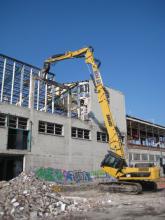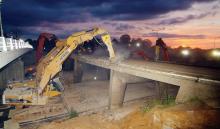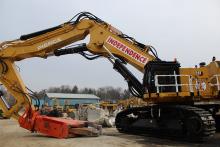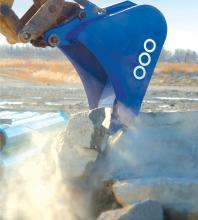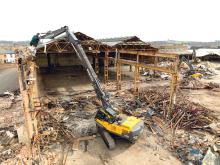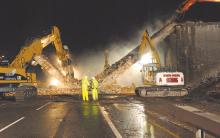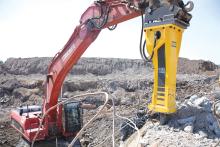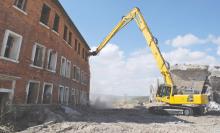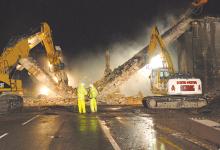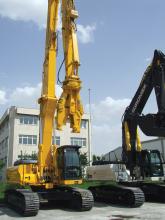Long reach demolition excavators are now special purpose machines, Dan Gilkes reports. The majority of construction equipment manufacturers offer a range of demolition specific machines, built to meet the needs of a sector of the industry that works its plant harder than most.
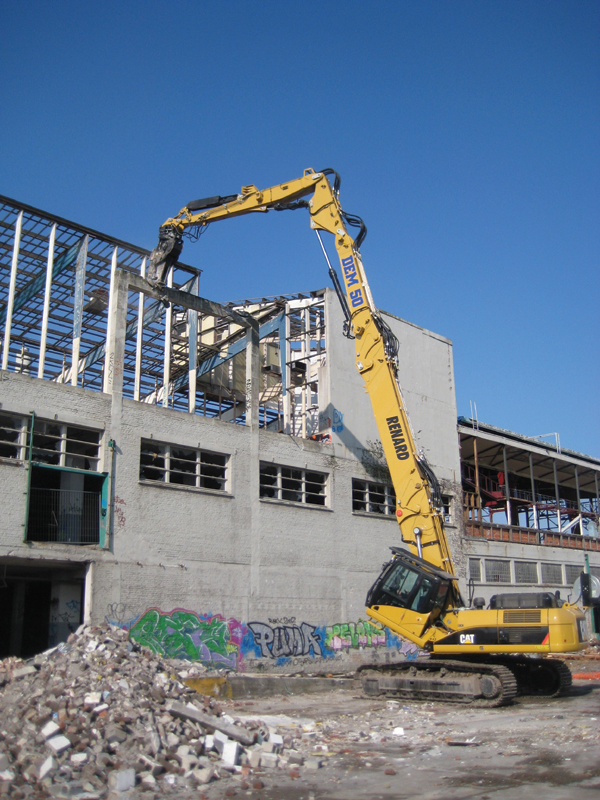
Caterpillar has now set up a partnership with French firm Versys called Demlone to build high reach demolition machines
Long reach demolition excavators are now special purpose machines, Dan Gilkes reports
The majority of construction equipment manufacturers offer a range of demolition specific machines, built to meet the needs of a sector of the industry that works its plant harder than most. Reinforced structures, additional hydraulic services, cab and body protection, dust suppression and additional engine air cleaners are just some of the standard alterations required by the demolition contractor.For many years excavator manufacturers sat back and watched conversion specialists take their carefully built machinery, strip it down, add these features along with longer booms and resell them for considerably more money. It did not take the original equipment manufacturers too long to realise that in fact they could do much of this work themselves, boosting profitability within their own operations and getting closer to the end customer in the process.
Komatsu has recently added to its mid-weight demolition line-up with the PC290LC-8 HRD, which tips the scales at 33-41tonnes depending on specification. The firm has a well established presence in the demolition sector, with models ranging from the PC240LC-8 HRD to the PC450LC-8 HRD.
This latest high reach machine can carry up to a 3 tonne work tool, with a maximum working height of 18.34m and a maximum forward reach of 10.7m. As with most rigs of this type a pinned digging boom is also available for added versatility, offering a choice of 2.6m and 3.2m dipper sticks for a maximum digging depth of 7.1m.
The PC290LC-8 HRD is built at Komatsu's factory in Birtley, England, with boom design and construction carried out on site. The machine comes with a demolition specification tilting cab, with level 2 FOPS guard and roof screen as standard.
However while so many manufacturers have been moving into making high reach demolition booms in-house, such as this latest Komatsu model, Caterpillar is now taking the opposite approach. The US giant had been manufacturing its own demolition equipment for some time, but has now decided that it would be better off working in partnership with a dedicated high reach specialist.
Cat has therefore joined forces with French manufacturer
Offering a choice of 18m, 21m and 23m working heights, the 45-48tonne DEM50 uses the undercarriage and strengthened upperstructure from Cat's 336D crawler excavator. Designed to work with attachments weighing up to 3tonnes, the rig uses a main boom section, 3m and 5m extensions and a single stick, allowing customers to rapidly change the height configuration to suit the job.
Equipped with a hydraulic boom foot coupler, with the lower pins controlled from the cab. All of the hydraulic lines have quick couplers, so the boom configuration can be changed in around 20 minutes, rather than the 3-4 hours of previous machines.
Cat will even supply an optional standard reach digging arm, for customers who want to turn the machine back into a backhoe. This boom uses the same quick pin attachment system, adding to the versatility of the machine.
Caterpillar and Demlone aim to produce a full range of high reach demolition rigs, with the DEM70 offering working heights of 26m, 29, and 31m and a DEM100 stretching even higher.
Perhaps one of the most interesting machine developments of recent times has not been aimed at maximum height working at all, but more at manoeuvrability on congested urban sites. Designed and built by UK conversion specialist
The demolition rig offers a 21m working height, with a maximum work tool weight of 2.5tonnes, giving it similar performance to a conventional 36tonne model. A 30° tilting cab has been added, with full FOPS structure.
As the utility machine comes with a dozer blade as standard, there has been no requirement to fit wider track frames for increased stability. However Kocurek has added around 10tonnes of counterweight, to the top, rear and sides of the upper structure, taking operating weight to around 48tonnes.
Despite this additional counterweight, the machine retains its minimal rear overhang, giving it almost zero tailswing and allowing it to work in the most confined of site conditions. Following a number of demonstrations last year, the Kocurek Volvo has now been sold to a customer in Sweden, and is expected to start work in Stockholm in the coming months.
Of course having the right machine to get the job done is only one half of the equation. Finding an operator capable of working a high reach demolition rig safely and efficiently is another. Indeed it is not just the high reach models that require additional training, a road bridge may
not be that high up in the air, but it requires careful demolition to bring it down safely, particularly in a night-time road possession. Being able to build and construct does not automatically mean that an operator knows how to take a structure back down.
Demolition contractors have acknowledged for some time that, though the cab and controls may be similar, a high reach demolition rig is not an excavator. That means that to ensure safe operation on site, an operator should be trained and assessed on high reach equipment separately to any excavator training that they may have taken previously.
In the UK, the
The NDTG, which is a joint venture between
At present the NDTG offers four levels of training for demolition equipment operatives, all based around the CPCS (A65) card for high reach equipment. The basic training is in materials processing, which covers the use of attachments such as shears, pulverisers and hydraulic breakers. This gives the operator an A65A card.
There is then an A65B card that covers demolition up to 15m, an A65C card that takes in work up to 30m and the A65D card, which covers operators of machines capable of working above 30m.
In each case the operator has to take both a practical and a theory test, which incorporates health and safety, environmental and rights and responsibilities information. An operator does not have to work the way up the ladder and can go straight in at 30m plus, which then gives the A, B and C categories along with the D.
"Last year we trained 27 high reach operatives here, and 23 to the 15m standard," said NDTG training group manager Sophie Francis. "However there are other training centres around the UK, so the overall number is considerably higher." With this card standard now well established, the NDTG is pushing to create additional machine classes for other types of demolition equipment. It is currently in talks with CITB ConstructionSkills to create demolition specific training for skid steers, mini excavators and pedestrian-operated demolition machines, such as the Brokk radio-controlled boom.
"We're working with CPCS to develop smaller equipment categories in demolition," she said. "We've been working on this for over a year now, so hopefully the cards will be established by mid-2011." Demolition operatives who have had to take construction related training for smaller equipment will be offered a conversion process to gain their CCDO cards in these machine classes.
The
If the CCDO card scheme continues to promote well trained, safe demolition operatives capable of handling a wide range of demolition specific machinery, there will no doubt be a transfer of knowledge between these organisations in the future. By promoting industry specific training, and by using the right machinery for the task in hand in the first place, the demolition industry will continue to raise its professional profile, improving safety on site and cutting the time required to carry out demolition work.

